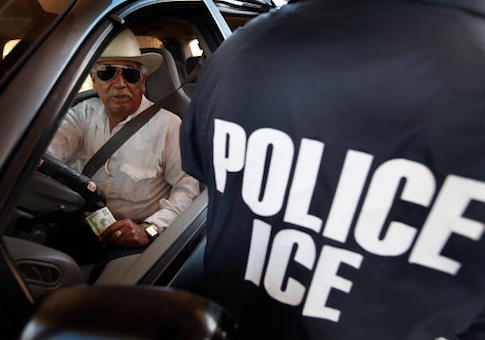After declining precipitously since 2009, arrests made by the U.S. Immigration and Customs Enforcement agency (ICE) rose 30 percent in the first full year of President Donald Trump's administration, an analysis released Thursday by the Pew Research Center revealed.
ICE agents made a total of 143,470 arrests in fiscal year 2017, as compared against 110,104 in FY 2016. That number is the highest in three years, according to Pew's analysis of the past nine years of ICE arrests.
That surge happened almost exclusively following Trump's swearing in: Between Inauguration Day on January 20 and the end of the fiscal year on September 30, ICE made 42 percent more arrests than it did over the same period in FY 2016.
Although those numbers increased, they are still substantially down from FY 2009, when ICE arrested 297,898 people. Pew's analysis shows that ICE arrests fell continuously over the course of President Barack Obama's administration.
This decline is likely attributable to the restricted removal priorities of the Obama White House, which focused on arresting and deporting those illegal aliens who were deemed threats to national security, public safety, and border security.
Shortly after taking office, Trump issued an executive order that expanded the category of priorities for removal to include those who had committed, been charged with, or convicted of any crime, not simply those posing a threat to the aforementioned three concerns. The expanded order also allowed the targeting of any illegal resident who had "abused any program related to receipt of public benefits," e.g., illegally received welfare benefits.
According to the report which Pew analyzed, ICE considers its increase in deportations to be a successful fulfillment of its mission.
"The FY2017 statistics clearly demonstrate ICE's continued commitment to identifying, arresting, and removing aliens who are in violation of U.S. law, particularly those posing a public safety or national security threat, while restoring fidelity to the rule of law," the report read.
The increase under the Trump administration has not been evenly distributed across the country, Pew noted. ICE reports coverage based on areas defined in proximity to field offices. The biggest increases in arrests were concentrated around the Dallas field office (covering northern Texas and Oklahoma), the Miami field office (covering all of Florida), and the St. Paul field office (covering Minnesota, Iowa, Nebraska, and North and South Dakota).
Notably, there were comparatively small increases in most of the field office regions along the southwestern border. The four field offices covering the border—San Diego, Phoenix, El Paso, and San Antonio—saw increases between 20 and 1 percent. By contrast, larger increases occurred throughout much of the south and the New England region. The patterns are similar—although not precisely the same—in terms of raw numbers as opposed to percentages.
This, Pew points out, means that ICE arrests did not necessarily increase in proportion to proximity to the border, nor to concentrations of illegal residents. Some of that disparity may be attributable to sanctuary city and state policies. The New York City field office region saw just 2,600 arrests in FY 2017, for example, even though it has a large illegal immigrant population. Earlier this year, the city further fortified its noncompliance with federal immigration laws.
While ICE appears to be focusing its enforcement efforts within the country, it shares those responsibilities with U.S. Citizenship and Immigration Services and U.S. Customs and Border Patrol Agency. The latter agency, according to recently reported data, continues to turn away would-be illegal entrants at the border, including some 35,000 in January.
